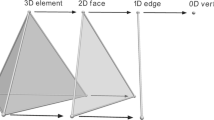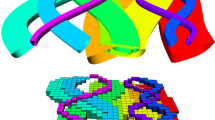Abstract
Grid generation is critical to numerical reservoir simulations. High-quality grids guarantee the fidelity of a reservoir model and keep the flow calculations simple. In this study, we propose a 3D unstructured grid, the generalized prism grid (GPG), to model reservoirs with complicated geological geometries, including horizons, pinch-outs, faults, fractures, and bore holes. GPG is a layered, pillar-based grid. The location of a face node is specified by its elevation, and the pillar to which it is attached. Compared with the hexahedral corner point grid (CPG), GPG is a polygon prism and therefore more flexible; whereas, compared with the 2.5D perpendicular bisection (PEBI) grid, GPG allows polygons morphing through the stratum. We built a gridding algorithm to fulfil the features of GPG. The algorithm first constructs a 2D triangular mesh for one layer by setting up control points and grid densities for geological objects, such as fractures, faults, and wells, distributing triangular grid points with the “advancing front method,” and performing Delaunay optimization to the points. The polygon mesh is the dual grid of the triangular mesh. Taking the polygon mesh as a reference, the mesh for each layer of the strata is a morphing of it, with edges being stretched and points being assigned with heights. We also designed a compact file format to store GPG data and implemented the flux calculation method for GPG in a reservoir simulator. The attractive features of GPG are demonstrated through four examples. The conciseness and flexibility of GPG make it a potential new standard grid format replacing CPG.
Similar content being viewed by others
References
Aavatsmark, I., Eigestad, G.T., Mallison, B.T., Nordbotten, J.M.: A compact multipoint flux approximation method with improved robustness. Numerical Methods for Partial Differential Equations 24(5), 1329–1360 (2008). https://doi.org/10.1002/num.20320
Aavatsmark, I., Eigestad, G.T., Heimsund, B.-O., Mallison, B.T., Nordbotten, J.M., Cian, E.: A New Finite-Volume Approach to Efficient Discretization on Challenging Grids. Paper Presented at the SPE Reservoir Simulation Symposium, Houston, Texas, USA (2007)
Aavatsmark, I.: An introduction to multipoint flux approximations for quadrilateral grids. Comput. Geosci. 6(3), 405–432 (2002). https://doi.org/10.1023/A:1021291114475
Brezzi, F., Lipnikov, K., Shashkov, M.: Convergence of the mimetic finite difference method for diffusion problems on polyhedral meshes. SIAM J. Numer. Anal. 16(02), 275–297 (2005). https://doi.org/10.1137/040613950
Brezzi, F., Lipnlkov, K., Simoncini, V.: A family of mimetic finite difference methods on polygonal and polyhedral meshes. Mathematical Models & Methods in Applied Sciences 15(10), 1533–1551 (2005). https://doi.org/10.1142/S0218202505000832
Hyman, J., Morel, J., Shashkov, M., Steinberg, S.: Mimetic finite difference methods for diffusion equations. Comput. Geosci. 6(3), 333–352 (2002). https://doi.org/10.1023/A:1021282912658
Lipnikov, K., Manzini, G., Shashkov, M.: Mimetic finite difference method. J. Comput. Phys. 257, 1163–1227 (2014). https://doi.org/10.1016/j.jcp.2013.07.031
Nikitin, K., Terekhov, K., Vassilevski, Y.: A monotone nonlinear finite volume method for diffusion equations and multiphase flows. Comput. Geosci. 18(3), 311–324 (2014). https://doi.org/10.1007/s10596-013-9387-6
Klemetsdal, Ø.S., Berge, R.L., Lie, K.A., Nilsen, H.M., Møyner, O.: Unstructured Gridding and Consistent Discretizations for Reservoirs with Faults and Complex Wells. Paper Presented at the SPE Reservoir Simulation Conference, Montgomery, Texas, USA (2017)
Nelson, R.A.: 1. Evaluating Fractured Reservoirs: Introduction. In: Geologic analysis of naturally fractured reservoirs. 2nd edn., pp 1–100. Gulf Professional Publishing, Woburn (2001)
Ding, Y., Lemonnier, P.: Use of corner point geometry in reservoir simulation. Paper presented at the International Meeting on Petroleum Engineering, Beijing China (1995)
Aarnes, J.E., Krogstad, S., Lie, K.-A.: Multiscale mixed/mimetic methods on corner-point grids. Comput. Geosci. 12(3), 297–315 (2008). https://doi.org/10.1007/s10596-007-9072-8
Ponting, D.K.: Corner point grid geometry in reservoir simulation. Paper presented at the Proc., First European Conference Math Oil Recovery (1989)
Wadsley, W.A.: Modelling reservoir geometry with non-rectangular coordinate grids Paper presented at the SPE Annual Technical Conference and Exhibition (1980)
Goldthorpe, W.H., Chow, Y.S.: Unconventional Modelling of Faulted Reservoirs: a Case Study. Paper Presented at the SPE Reservoir Simulation Symposium, Dallas, Texas (1985)
Bennis, C., Borouchaki, H., Flandrin, N.: 3D conforming power diagrams for radial LGR in CPG reservoir grids. Engineering with Computers 24(3), 253–265 (2008). https://doi.org/10.1007/s00366-008-0098-x
Quandalle, P.: Eighth SPE Comparative Solution Project: Gridding Techniques in Reservoir Simulation. Paper Presented at the 1 Symposium on Reservoir Simulation, New Orleans, Louisiana (1993)
Pedrosa Jr., O.A., Aziz, K.: Use of a hybrid grid in reservoir simulation SPE Reservoir Engineering. https://doi.org/10.2118/13507-PA (1986)
Borouchaki, H., George, P.L., Lo, S.H.: Optimal delaunay point insertion. Int. J. Numer. Methods Eng. 39(20), 3407–3437 (2015). https://doi.org/10.1002/(SICI)1097-0207(19961030)39:203407::AID-NME53.0.CO;2-C
George, P.L., Borouchaki, H.: Delaunay triangulation and meshing hermès (1998)
Mlacnik, M.J., Durlofsky, L.J., Heinemann, Z.E.: Dynamic Flow-Based PEBI Grids for Reservoir Simulation. Paper Presented at the SPE Annual Technical Conference and Exhibition, Houston, Texas (2004)
Palagi, C.L., Aziz, K.: Use of Voronoi grid in reservoir simulation SPE-22889-PA. https://doi.org/10.2118/22889-PA (1994)
Fung, L.S.K., Buchanan, L., Ravi, S.: Hybrid-CVFE method for flexible-grid reservoir simulation SPE Reservoir Engineering. https://doi.org/10.2118/25266-PA (1994)
Jackson, M.D., Gomes, J.L.M.A., Mostaghimi, P., Percival, J.R., Tollit, B.S., Pavlidis, D., Pain, C.C., El-Sheikh, A.H., Muggeridge, A.H., Blunt, M.J.: Reservoir Modeling for Flow Simulation Using Surfaces, Adaptive Unstructured Meshes, and Control-Volume-Finite-Element Methods. Paper Presented at the SPE Reservoir Simulation Symposium, The Woodlands, Texas, USA (2013)
Vestergaard, H., Olsen, H., Sikandar, A.S., Abdulla, I.A., Noman, R.: The application of unstructured gridding techniques for full field simulation of a giant carbonate reservoir developed with long horizontal wells Paper presented at the International Petroleum Technology Conference (2007)
Farrashkhalvat, M., Miles, J.: Basic structured grid generation: with an introduction to unstructured grid generation Butterworth-Heinemann (2003)
Thompson, J.F., Soni, B.K., Weatherill, N.P.: Handbook of grid generation CRC Press (1998)
Palagi, C.L., Aziz, K.: Modeling vertical and horizontal wells with Voronoi grid SPE-24072-PA. https://doi.org/10.2118/24072-PA (1994)
Pirzadeh, S.: Structured background grids for generation of unstructured grids by advancing-front method. Aiaa J. 31(2), 285–289 (1991). https://doi.org/10.2514/3.11662
Batina, J.T.: Unsteady Euler airfoil solutions using unstructured dynamic meshes. AIAA J. 28(8), 1381–1388 (1989). https://doi.org/10.2514/3.25229
Mallet, J.L.: Discrete smooth interpolation. ACM Trans Graph. 8(2), 121–144 (1989). https://doi.org/10.1145/62054.62057
Mallet, J.L.: Discrete smooth interpolation in geometric modelling. Comput. Aided Des. 24(4), 178–191 (1992). https://doi.org/10.1016/0010-4485(92)90054-E
Freitag, L.A.: On combining Laplacian and optimization-based mesh smoothing techniques. ASME applied mechanics division-publications-amd 220, 37–44 (1997)
Field, D.A.: Laplacian smoothing and delaunay triangulations. J. Communications in Applied Numerical Methods 4, 709–712 (1998). https://ci.nii.ac.jp/naid/80004258763/en/
Yang, C., Xue, X., King, M.J., Datta-Gupta, A.: Flow simulation of complex fracture systems with unstructured grids using the fast marching method. Paper presented at the SPE/AAPG/SEG Unconventional Resources Technology Conference, Austin, Texas USA (2017)
Branets, L., Ghai, S.S., Lyons, S.L., Wu, X.-H.: Efficient and Accurate Reservoir Modeling Using Adaptive Gridding with Global Scale Up. Paper Presented at the SPE Reservoir Simulation Symposium, The Woodlands, Texas (2009)
Pirzadeh, S.: Unstructured grid generation by advancing front method using structured background grids. In: Napolitano, M., Sabetta, F (eds.) 13th international conference on numerical methods in fluid dynamics: proceedings of the conference held at the Consiglio Nazionale delle Ricerche Rome, Italy, 6–10 July 1992, pp 285–289. Springer, Berlin (1993)
Schenk, O., Gärtner, K.: Solving unsymmetric sparse systems of linear equations with PARDISO. Futur. Gener. Comput. Syst. 20(3), 475–487 (2004). https://doi.org/10.1016/j.future.2003.07.011
Schenk, O., Gärtner, K., Fichtner, W., Stricker, A.: PARDISO: a high-performance serial and parallel sparse linear solver in semiconductor device simulation. Futur. Gener. Comput. Syst. 18(1), 69–78 (2001). https://doi.org/10.1016/S0167-739X(00)00076-5
George, J.A.: Computer implementation of the finite element method. Department of Computer Science, Standford University, CA USA (1971)
Mavriplis, D.J.: An advancing front Delaunay triangulation algorithm designed for robustness. J. Comput. Phys. 117(1), 90–101 (1995). https://doi.org/10.1006/jcph.1995.1047
Müller, J.D., Roe, P.L., Deconinck, H.: A frontal approach for internal node generation in Delaunay triangulations. Int. J. Numer. Methods Fluids 17(3), 241–255 (1993). https://doi.org/10.1002/fld.1650170305
Shewchuk, J.R.: Triangle: Engineering a 2D quality mesh generator and delaunay triangulator. In: Lin, M.C., Manocha, D. (eds.) Applied Computational Geometry Towards Geometric Engineering: FCRC’96 Workshop, WACG’96 Philadelphia, PA, May 27–28, 1996 Selected Papers, pp 203–222. Springer, Berlin (1996)
Sederberg, T.W., Parry, S.R.: Free-form deformation of solid geometric models. SIGGRAPH Comput Graph. 20(4), 151–160 (1986). https://doi.org/10.1145/15886.15903
Coquillart, S.: Extended free-form deformation: a sculpturing tool for 3D geometric modeling. SIGGRAPH Comput Graph. 24(4), 187–196 (1990). https://doi.org/10.1145/97880.97900
Modat, M., Ridgway, G.R., Taylor, Z.A., Lehmann, M., Barnes, J., Hawkes, D.J., Fox, N.C., Ourselin, S.: Fast free-form deformation using graphics processing units. Comput. Methods Prog. Biomed. 98(3), 278–284 (2010). https://doi.org/10.1016/j.cmpb.2009.09.002
Sorkine, O., Cohen-Or, D., Lipman, Y., Alexa, M., Seidel, H.-P.: Laplacian Surface Editing Paper Presented at the Proceedings of The 2004 Eurographics/ACM SIGGRAPH symposium on Geometry processing, Nice, France (2004)
Yu, Y., Zhou, K., Xu, D., Shi, X., Bao, H., Guo, B., Shum, H.-Y.: Mesh editing with poisson-based gradient field manipulation. ACM Trans Graph. 23(3), 644–651 (2004). https://doi.org/10.1145/1015706.1015774
Alexa, M.: Differential coordinates for local mesh morphing and deformation. Vis. Comput. 19(2), 105–114 (2003). https://doi.org/10.1007/s00371-002-0180-0
Farhat, C., Degand, C., Koobus, B., Lesoinne, M.: Torsional springs for two-dimensional dynamic unstructured fluid meshes. Comput. Methods Appl. Mech. Eng. 163(1), 231–245 (1998). https://doi.org/10.1016/S0045-7825(98)00016-4
Murayama, M., Nakahashi, K., Matsushima, K.: Unstructured dynamic mesh for large movement and deformation. AIAA paper 122, 2002 (2002)
Peaceman, D.W.: Interpretation of well-block pressures in numerical reservoir simulation with nonsquare grid blocks and anisotropic permeability. Soc. Pet. Eng. J. 18(3), 183–194 (1983). https://doi.org/10.2118/10528-PA
Li, X., Zhang, D., Li, S.: A multi-continuum multiple flow mechanism simulator for unconventional oil and gas recovery. Journal of Natural Gas Science and Engineering 26, 652–669 (2015). https://doi.org/10.1016/j.jngse.2015.07.005
Li, X., Zhang, D.: A backward automatic differentiation framework for reservoir simulation. Comput. Geosci. 18(6), 1009–1022 (2014). https://doi.org/10.1007/s10596-014-9441-z
Funding
This work is partially funded by the National Natural Science Foundation of China (Grant Nos. U1663208 and 51520105005), the Beijing Municipal Science and Technology Commission (Z171100002317022), and the National Science and Technology Major Project of China (Grant Nos. 2016ZX05037-003 and 2017ZX05049-003). The data used are available upon request from the corresponding author.
Author information
Authors and Affiliations
Corresponding author
Ethics declarations
Conflict of interests
The authors declare that they have no conflict of interest.
Appendix: 1: A simple example to illustrate the data format of GPG
Appendix: 1: A simple example to illustrate the data format of GPG
In the following script, each “#” leads a comment line. The grid is shown in Fig. 25.
GPG
# NGNVNlyNPNPP
8 72 2 11 26
PCOORD
# nPPx1y1d1x2y2d2x3y3d3
2 41.3 54.9 0.0 41.3 54.9 8.0
3 41.7 41.7 0.0 41.7 41.2 6.0 41.7 40.7 8.0
2 52.0 54.8 0.0 52.0 54.8 8.0
2 14.7 53.8 0.0 14.7 53.8 8.0
3 20.8 40.4 0.0 20.8 39.4 6.0 20.8 38.4 8.0
3 29.9 34.3 0.0 29.9 33.8 6.0 29.9 33.3 8.0
2 41.3 70.1 0.0 41.3 70.1 8.0
2 59.9 63.8 0.0 59.8 58.0 5.0 59.8 58.0 8.0
2 59.8 58 0.0 59.8 58.0 8.0
2 28.0 75.6 0.0 28.0 75.6 8.0
2 14.2 66.2 0.0 14.2 66.2 8.0
PIND
# Length and Pillar indices
3 1 2 3
5 4 5 6 2 1
5 1 7 8 9 3
5 1 7 10 11 4
PZCORN
# Every two lines are to define the depths of the top and the
# bottom faces of a prism grid, respectively. The order of
# numbers is coincided with the order of pillars defined in
# PIND.
2.0 2.0 2.0
6.0 6.0 6.0
2.0 2.0 2.0 2.0 2.0
6.0 6.0 6.0 6.0 6.0
0.0 0.0 0.0 0.0 0.0
5.0 5.0 5.0 5.0 5.0
0.0 0.0 0.0 0.0 0.0
5.0 5.0 5.0 5.0 5.0
6.0 6.0 6.0
8.0 6.4 8.0
6.0 6.0 6.0 6.0 6.0
8.0 6.4 6.0 6.4 8.0
5.0 5.0 5.0 5.0 5.0
8.0 8.0 8.0 8.0 8.0
5.0 5.0 5.0 5.0 5.0
8.0 8.0 8.0 8.0 8.0
PFAULTS
# name k1 k2 m1m2 NFP p1 p2 p3
‘Fault1’ 1 2 0 0 3 4 1 3
Rights and permissions
About this article
Cite this article
Li, X., Li, X. & Zhang, D. Generalized prism grid: a pillar-based unstructured grid for simulation of reservoirs with complicated geological geometries. Comput Geosci 22, 1561–1581 (2018). https://doi.org/10.1007/s10596-018-9774-0
Received:
Accepted:
Published:
Issue Date:
DOI: https://doi.org/10.1007/s10596-018-9774-0





